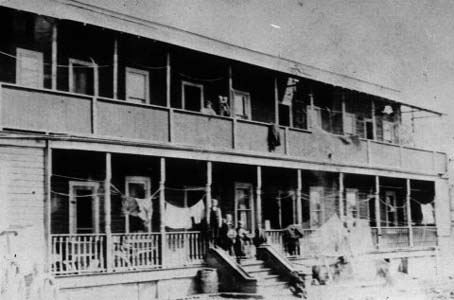Search | Image Archive | Reference | Communities | POV | Lesson Plans | Credits
 For many new immigrants to Manitoba, their first prolonged exposure to their new country was the streets of Point Douglas. Defined by a bend in the River, Point Douglas was the location of the Canadian Pacific passenger terminal where most new immigrants stepped off the train. Not far from the terminal were the immigration sheds, barracks-like facilities where new arrivals without any place else to stay could live for a short period while they looked for work in the city or prepared to move to a rural homestead.
For many new immigrants to Manitoba, their first prolonged exposure to their new country was the streets of Point Douglas. Defined by a bend in the River, Point Douglas was the location of the Canadian Pacific passenger terminal where most new immigrants stepped off the train. Not far from the terminal were the immigration sheds, barracks-like facilities where new arrivals without any place else to stay could live for a short period while they looked for work in the city or prepared to move to a rural homestead.
In the 1880s Point Douglas had been an affluent residential area - a northern suburb of a Winnipeg still centred on the old Fort Garry. It was home to the houses of many Winnipeg business owners and entrepreneurs, and also to the mansions of business leaders like James Ashdown. By the turn of the century, however, the area was becoming increasingly industrialized, and residents like Ashdown fled south to the less developed neighbourhoods of Broadway, Armstrong's Point and Crescentwood.
The reason that Point Douglas became one of Winnipeg's most important industrial areas was its proximity to railway facilities. The Canadian Pacific Main Line crossed the bridge over the Red River from St. Boniface into the heart of Point Douglas. Building close to the railway reduced transportation costs, and Point Douglas became home to a variety of enterprises from farm implements manufacturers and paint mixers to breweries and flour mills. The largest of these enterprises, the Vulcan Iron Works was one of the largest foundries in the west and it stretched for several blocks and employed hundreds of workers.
Point Douglas was never transformed in to an exclusively industrial area, but remained a mixed neighbourhood of housing and industrial enterprises. Residential districts were therefore located within walking distance of the factories and shops, and Point Douglas was home to a variety of houses, rooming houses and apartments. By the second decade of the twentieth century, many workers took advantage of the increasing popularity of the bicycle and Winnipeg's developing Electric Street Railway and moved to quieter residential neighbourhoods elsewhere in the North End. Those who remained behind were often the newest immigrants or the poorest paid workers. In 1909, two streets in Point Douglas were established as Winnipeg's Red Light District, further reducing the desirability of the neighbourhood and accelerating the process of decay.
TimeLinks Characters: Marianna Kociolinska, a midwife from Poland, lives with her family in Point Douglas.
Page revised: 29 August 2009